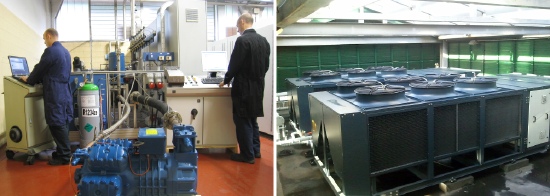The future of F gases?

Now that the EU has a framework policy for F gases, Tim Mitchell and Roberto Mallozzi of Klima-Therm reflect on the future for refrigerants with high GWPs.
The recent changes to the F gas Regulation, agreed earlier this by the EU after an often fevered debate, mark an important watershed for the industry. The new framework effectively sounds the death-knell for HFC refrigerants with high global-warming potential (GWP). This includes some of the most common refrigerants in use in building services.
The new Regulation comes into force on 1 January 2015 and introduces new conditions to the legal framework governing the use of F gases. This includes product and service bans, and a phase-down timetable for HFC refrigerants with the highest GWPs.
The regulation bans the sale of a number of products used in building services and refrigeration, including:
• Domestic refrigerators and freezers containing HFCs with a GWP of 150 or higher from 1 January 2015, as follows.
• Refrigerators and freezers for commercial use containing HFCs with a GWP of 2500 or higher from 1 January 2020 and those containing HFCs with a GWP of 150 or more from 1 January 2022.
• Stationary refrigeration equipment running on HFCs with a GWP of 2500 or more from 1 January 2020.
• Centralised refrigeration systems for commercial use with a capacity of 40 kW or more that use F-Gases with a GWP of 150 or more, from 1 January 2022;
• Movable room air-conditioning appliances that contain HFCs with GWP of 150 or more from 1 January 2020;
• Single split air-conditioning systems containing less than 3 kg of F gases with a GWP of 750 or more from 1 January 2025.
• Foams that contain HFCs with a GWP of 150 or more; extruded polystyrene from 1 January 2020, and other foams from 1 January 2023; and
• Technical aerosols that contain HFCs with a GWP of 150 or more from 1 January 2018.
The phase-down is based on a gradually declining cap on the total amount of bulk HFCs (in tonnes of CO2 equivalent) that can be placed on the market in the EU, with a freeze in 2015, followed by the first step reduction in 2016/17, and reaching 21% of levels sold in 2009-12 by 2030.

Given the extended timescales, it may be tempting to think that nothing much will happen for several years. However, we believe publication of the new F Gas framework effectively spells an end to business as usual for the industry and end users.
The reality is that well-informed and environmentally-conscious end users have been nervous for some time of investing further in conventional HFC-based technology because of the possibility of a future ban or tighter controls on high GWP refrigerants. Given the expected 10 to 15 year working life of expensive capital plant such as chillers, this is understandable.
With the ratification of the revised F gas Regulation, we now have a clear timetable for the phase-down of the most damaging HFCs. Intelligent investments in new and replacement plant will need to take account of the implications.
The practical consequences will be that a number of common HFC refrigerants currently used in chillers and air conditioning equipment will be replaced by other gases. Popular refrigerants such as R134a and R410A (which have GWPs of 1300 and 1975, respectively, will eventually be among those affected.
In their place, we anticipate growth in the use of low GWP refrigerants such as HFOs, which have only a fraction of the impact of many HFCs. For example, R1234ze — already commercially available — has a GWP of just six. A variant, HFO1234yf, has a lower-still GWP of just four.
We have been involved in a number of successful projects involving the use of Turbomiser chillers running HFO1234ze in place of R134a. While specific capacity is slightly lower, efficiency can be higher.
The other key trend we see is the fall from prominence of R410A, which has been standard in splits and VRF/V systems for some time. R410A looks likely to be replaced by R32, an HFC with a much lower GWP (550).
The issue here is that R32 is mildly flammable at certain conditions. If the big manufacturers opt for this, the building-services industry will have to get to grips with designing for and handling a potentially flammable substance on a daily basis, after decades of dealing with non-flammable refrigerants.
It may also require investment in new refrigerant-recovery and charging equipment which, given the sharp competition and pressure on prices, will not be welcomed by users or installers.
The new F gas Regulation marks the start of a new era for the industry. It will mean the phase-down in use of a number of common refrigerants and their replacement by new, non-standard refrigerants. In the most likely scenario, we believe this will mean a move towards mainstream use of HFO-based refrigerants and low GWP HFCs which are mildly flammable.
Those with major investment decisions pending on plant will need to fully inform themselves about the changes, and weigh up the options carefully.







